Nick’s Recommended Hedges from Minnesota Collection
Nick Kreevich, Associate Curator, Minnesota Landscape Arboretum
| Amelanchier canadensis ‘Glenn Form’ Rainbow Pillar® Rainbow Pillar serviceberry (20060784) |
||
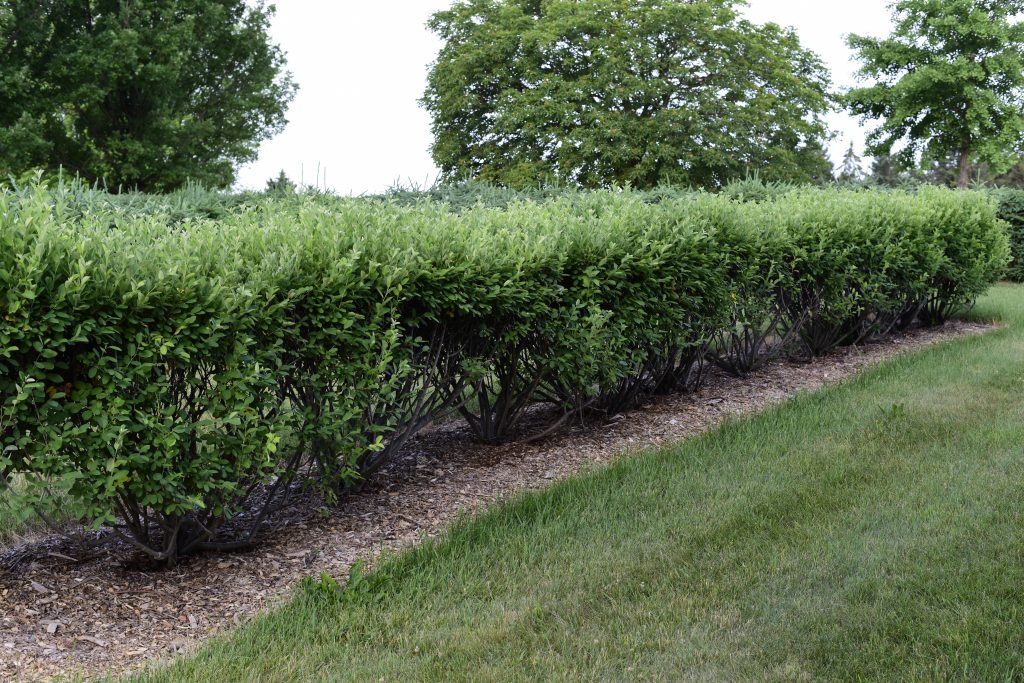 |
Form/Shape: | Best suited for a formal-shaped hedge due to architectural interest at base of hedge and sharper edges at top of hedge |
| Privacy: | Semi-private to private, approximately 5ft+ tall at maturity | |
| Foliage: | Small green leaves change to shades of orange to red in the fall | |
| Flower: | Blooms in spring with white, showy flowers on old growth, which will form into blueish-green berries | |
| Maintenance: | Vigorous top growth; some holes/dieback in the hedge | |
| Pest/Disease Issues: | Rust, leaf spot, blight, powdery mildew, sawfly, leaf miner, borers and scale; few issues | |
| Berberis thunbergii ‘Bailgreen’ Jade Carousel® – Barberry (20040359) | ||
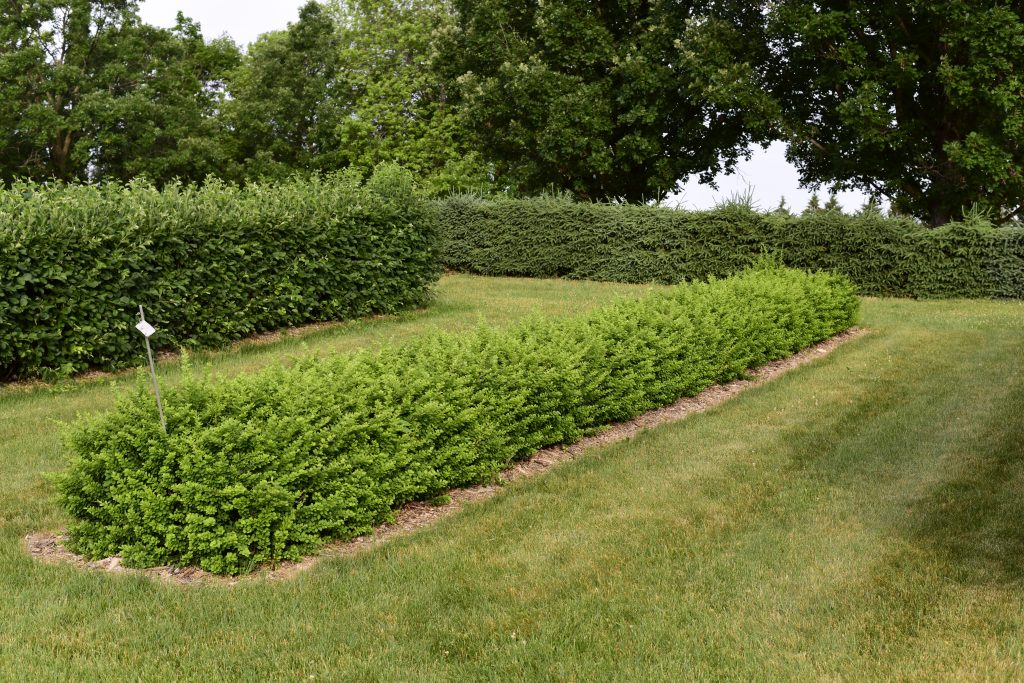 |
Form/Shape: | Best suited for a formal-shaped hedge due to compact and dense growth |
| Privacy: | Not private Approximately 2-6ft tall at maturity |
|
| Foliage: | Leaves emerge yellow-green in the spring, turning to deep green throughout growing season and change to a scarlet-orange in the fall | |
| Flower: | Ornamentally insignificant; blooms in spring with clusters of yellow flowers on old growth | |
| Maintenance: | Thorns are a nuisance, but slow growth allows less pruning maintenance; no holes in hedge; no weeds growing through | |
| Pest/Disease Issues: | Bacterial leaf spot, anthracnose, root rots, wilt, aphids, barberry webworm and scale | |
| Important Note: | In the eastern United States, the species Berberis thunbergii is known to be highly invasive through avian dispersion. | |
| Berberis thunbergii ‘BailErin’ Limoncello™ – Barberry (20160305) | ||
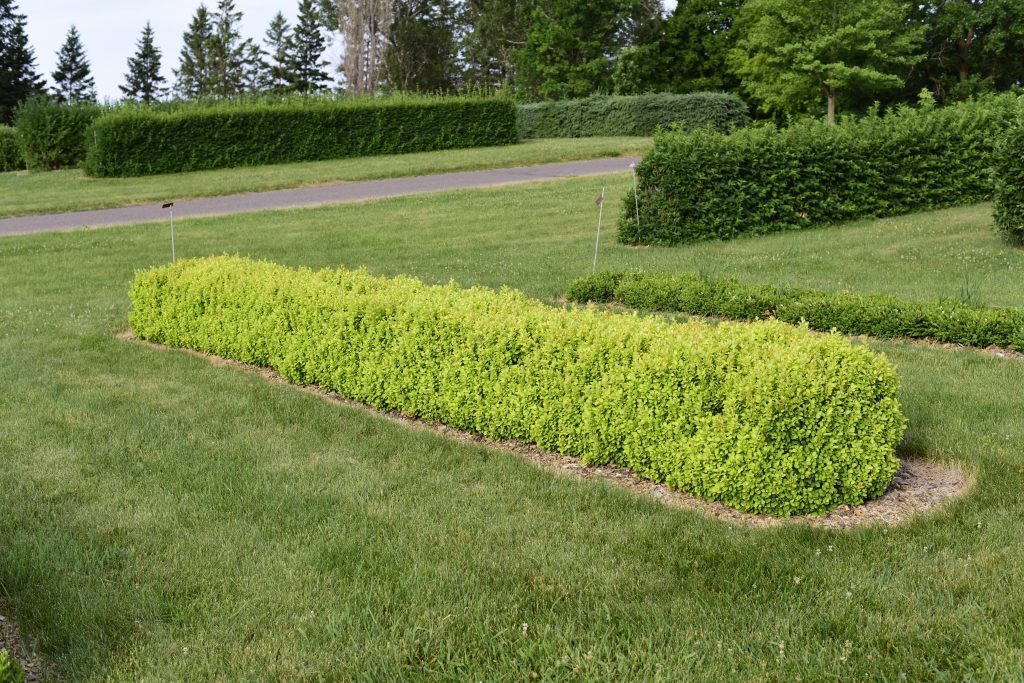 |
Form/Shape: | Best suited for a formal-shaped hedge due to compact and dense growth |
| Privacy: | Not private Approximately 2-6ft tall at maturity |
|
| Foliage: | Small, chartreuse-colored foliage with spotted red margins that turn to shades of orange, yellow, and red in the fall for late season interest | |
| Flower: | Ornamentally insignificant; blooms in spring with clusters of yellow flowers on old growth | |
| Maintenance: | Thorns are a nuisance, but slow growth allows less pruning maintenance; no holes in hedge; no weeds growing through | |
| Pest/Disease Issues: | Bacterial leaf spot, anthracnose, root rots, wilt, aphids, barberry webworm and scale | |
| Important Note: | In the eastern United States, the species, Berberis thunbergii is known to be highly invasive through avian transmission. |
| Caragana frutex ‘Globosa’ – Globe Peashrub (19540087) | ||
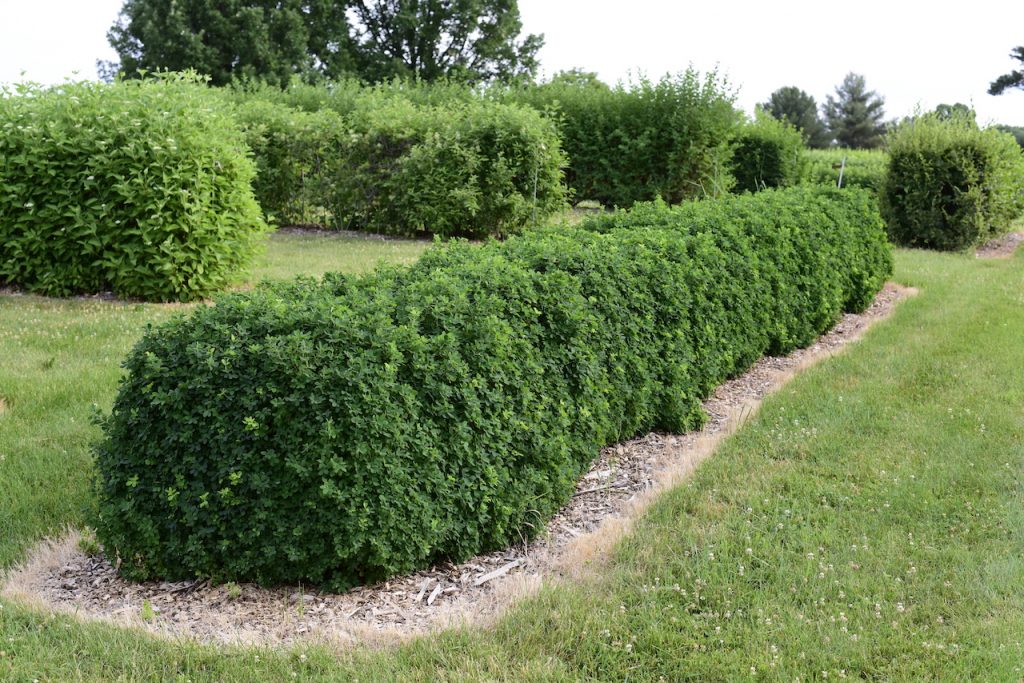 |
Form/Shape: | Best suited for a more rounded or organically shaped hedge |
| Privacy: | Not private to semi-private Approximately 3-4ft tall at maturity |
|
| Foliage: | Bluish-green leaves provide color interest throughout the growing season; leaves turning yellow in the fall add late growing season interest; small, round-shaped leaves provide textural interest | |
| Flower: | Blooms in spring with yellow pea-shaped flowers on old wood or on shoots that come off of old wood | |
| Maintenance: | Compact growth allows for more tidy shaping; however new growth can be vigorous; no weeds growing through; no holes in hedge; extremely drought tolerant | |
| Pest/Disease Issues: | Minor: stem decay, Septoria leaf spot, branch cankers; blister beetles |
| Chionanthus virginicus – White Fringe Tree (19620221) | ||
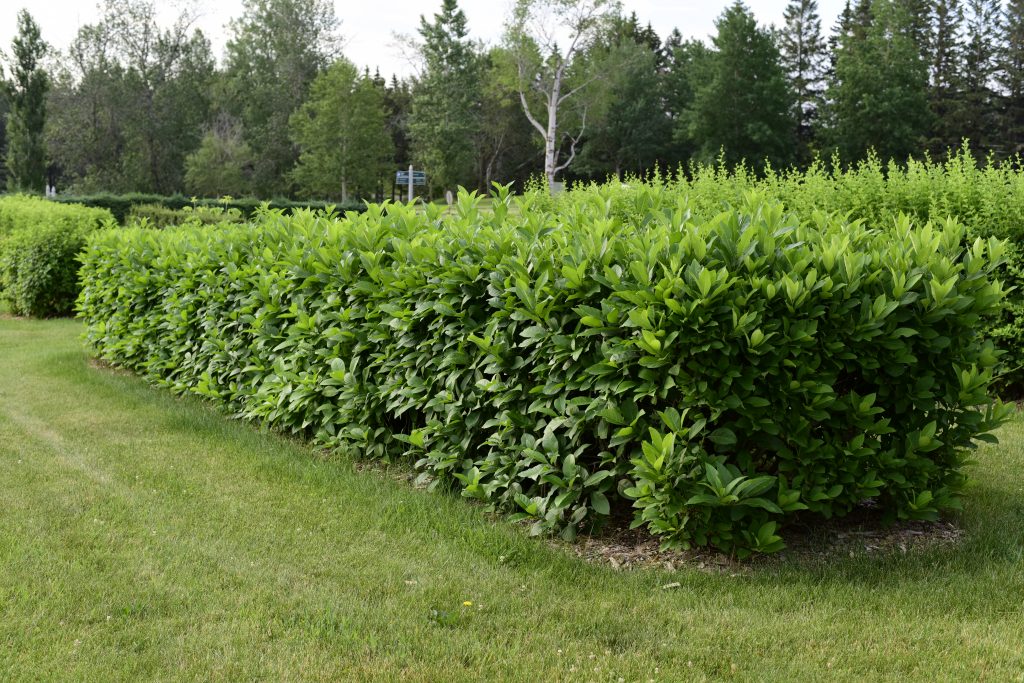 |
Form/Shape: | Best suited for a formal-shaped hedge due to dense foliage, tidiness, and height |
| Privacy: | Semi-private to private Approximately 5ft+ tall at maturity |
|
| Foliage: | Long, glossy, vibrant green leaves give way to shades of yellow in the fall, providing late season interest | |
| Flower: | Blooms in spring with showy, fragrant, white flowers on old growth | |
| Maintenance: | Growth on top of hedge appears to be vigorous; can show signs of stress during prolonged bouts of drought or heat stress; some weeds growing through | |
| Pest/Disease Issues: | Few to no pests |
| Diervilla lonicera – Bush Honeysuckle (19911104) | ||
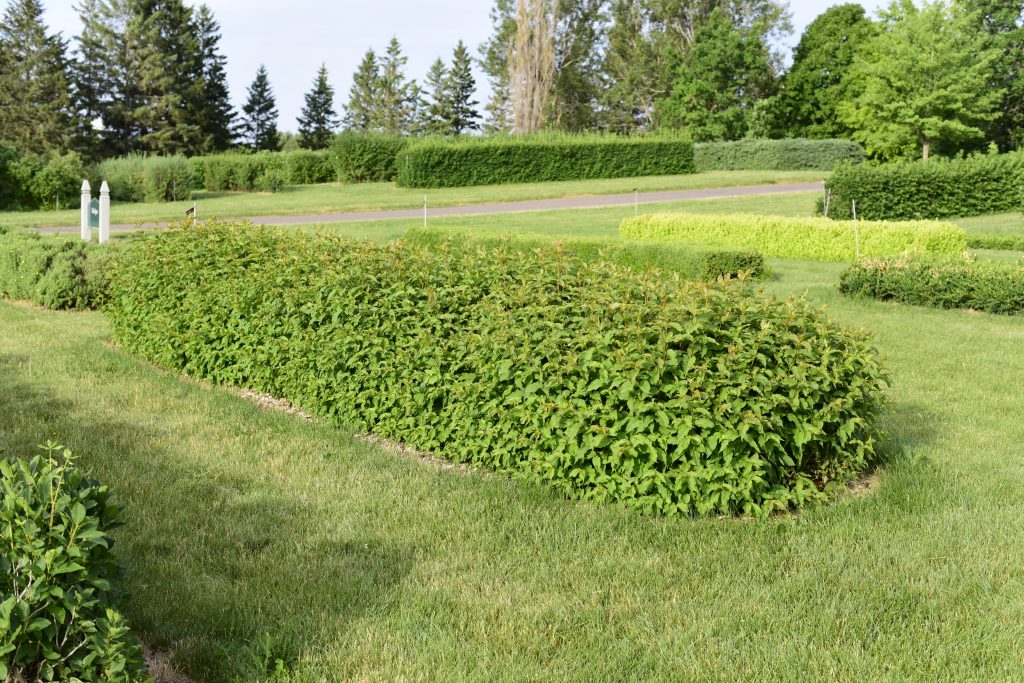 |
Form/Shape: | Best suited for a more rounded or organically shaped hedge |
| Privacy: | Not private Approximately 2-3ft tall at maturity |
|
| Foliage: | Foliage is dense, vibrant green, and turns to shades of yellow, orange ,and red in the fall | |
| Flower: | Blooms in summer with tubular-shaped, yellow flowers on new growth | |
| Maintenance: | Dense growth and small form provide less maintenance; performs well during drought stress due to nativity; due to colony forming habit, this shrub may require extra maintenance at base of hedge | |
| Pest/Disease Issues: | Minor: leaf spot and powdery mildew; few pests |
| Dirca palustris – Leatherwood (19660488) | ||
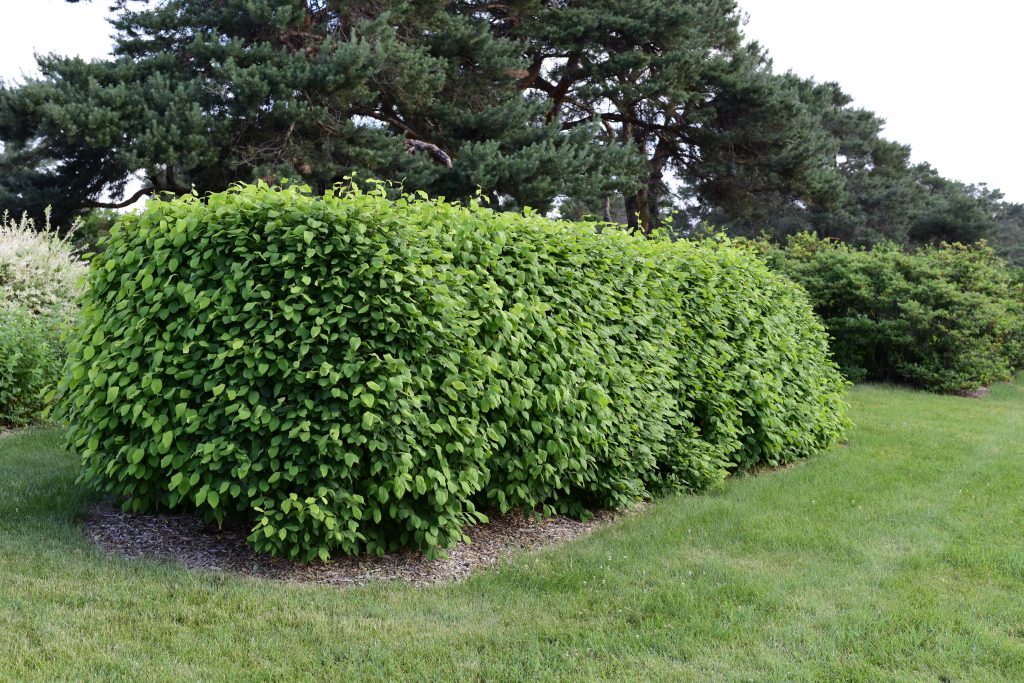 |
Form/Shape: | Best suited for a formal-shaped hedge due to dense foliage; softer and rounded edges with new growth |
| Privacy: | Private; approximately 4-6ft tall at maturity | |
| Foliage: | When leaves first emerge in spring, they are a bright green with yellow hues that fade to a deeper green later in the growing season; the foliage provides excellent fall interest, turning yellow | |
| Flower: | Ornamentally insignificant | |
| Maintenance: | Holds up well to heat and water stress; growth appears to be slower, so less pruning maintenance | |
| Pest/Disease Issues: | Minor; few pests |
| Hydrangea arborescens ‘Annabelle’ – Annabelle Hydrangea (20110551) | ||
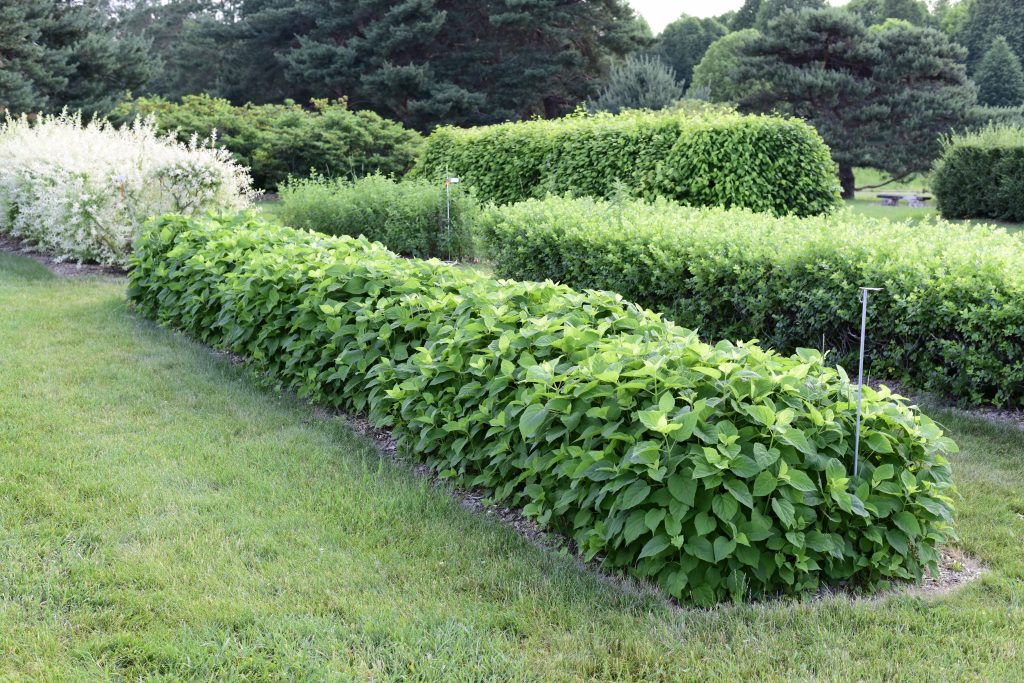 |
Form/Shape: | Best suited for a more rounded or organically shaped hedge |
| Privacy: | Not private to semi-private Approximately 3-5ft tall at maturity |
|
| Foliage: | Large green leaves provide dimension and textural interest; leaves turn yellow in the fall to provide fall interest | |
| Flower: | Blooms in early summer with large corymb inflorescences with white flowers; blooms on new growth | |
| Maintenance: | Vigorous growth and should be pruned in late winter or early spring to promote flowers | |
| Pest/Disease Issues: | Bud blight, bacterial wilt, leaf spots, mold, rust, powdery mildew, aphids, mites, scale, and nematodes |
| Hypericum kalmianum ‘Ames’ – Kalm St. John’s Wort (20160378) | ||
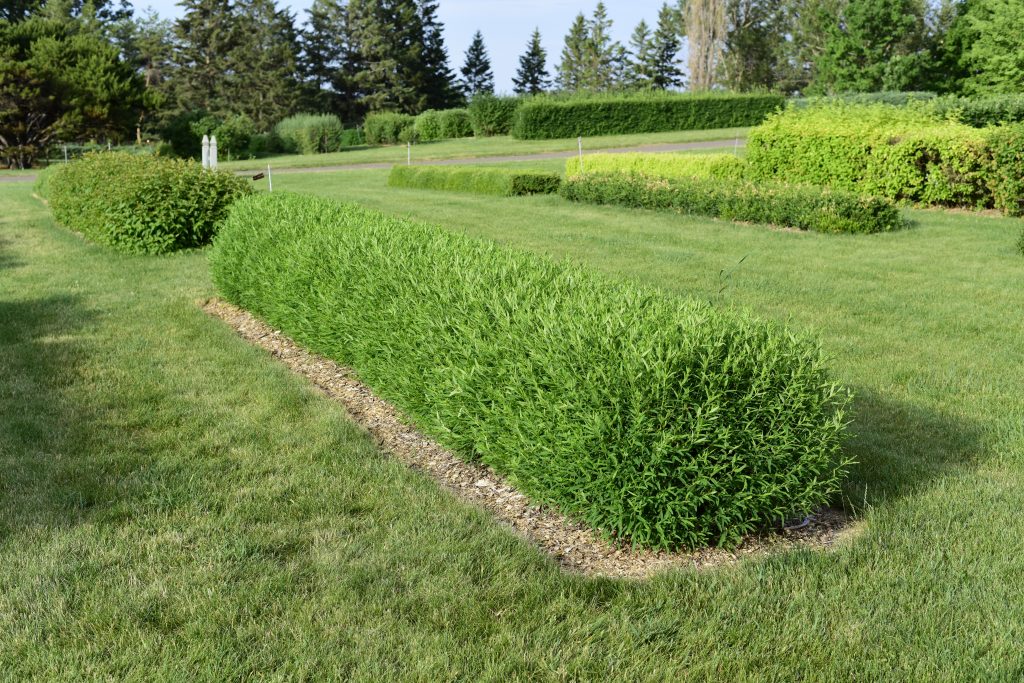 |
Form/Shape: | Best suited for a formal-shaped hedge due to compact, dense, and tidy growth |
| Privacy: | Not private; approximately 2-3ft tall at maturity | |
| Foliage: | Blueish-green foliage provides color interest, while narrow, linear-shaped leaves provide texture | |
| Flower: | Blooms in summer with yellow flowers on new growth | |
| Maintenance: | Dense and compact growth provide less maintenance for shaping into a hedge | |
| Pest/Disease Issues: | Minor; few pests |
| Juniperus chinensis ‘Maney’ – Maney Juniper (19610367) | ||
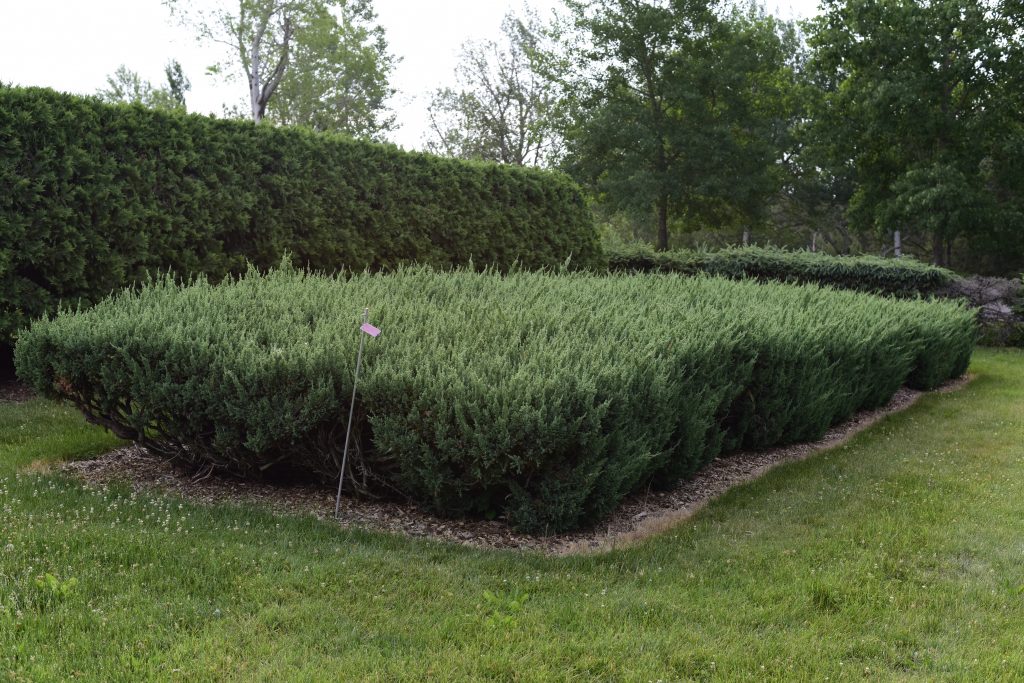 |
Form/Shape: | Best suited for a formal-shaped hedge due to architectural interest at base of hedge with sharp, clean edges at the top of the hedge |
| Privacy: | Semi-private; approximately 6 ft tall at maturity | |
| Foliage: | Powdery blue and evergreen foliage provides year-round interest that is also resistant to winter burn; foliage provides textural interest | |
| Flower: | Ornamentally insignificant | |
| Maintenance: | Slower growth provides less maintenance; takes to pruning well | |
| Pest/Disease Issues: | Tip and needle blights, cedar-apple rust, root rot, canker, aphids, bagworms, webworms, and scale |
| Picea x albertiana – White Spruce (20040281) | ||
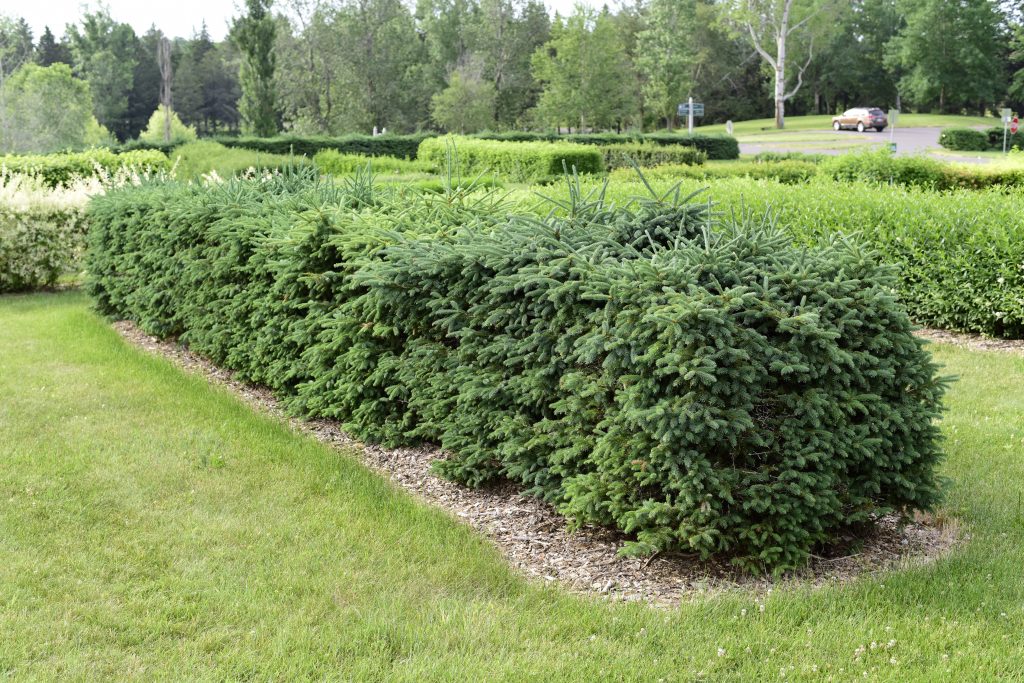 |
Form/Shape: | Best suited for a formal-shaped hedge due to dense foliage and height |
| Privacy: | Semi-private to private | |
| Foliage: | Approximately 40ft+ tall at maturity if not pruned as hedge | |
| Flower: | Ornamentally insignificant | |
| Maintenance: | Could prove to be high maintenance due to its mature height if not pruned; dense foliage can also be an issue within high humidity environments, trapping moisture | |
| Pest/Disease Issues: | Spruce budworm, spider mites; few pests |
| Potentilla fruticosa ‘UMan’ Mango Tango™ – Bush Cinquefoil (20100565) | ||
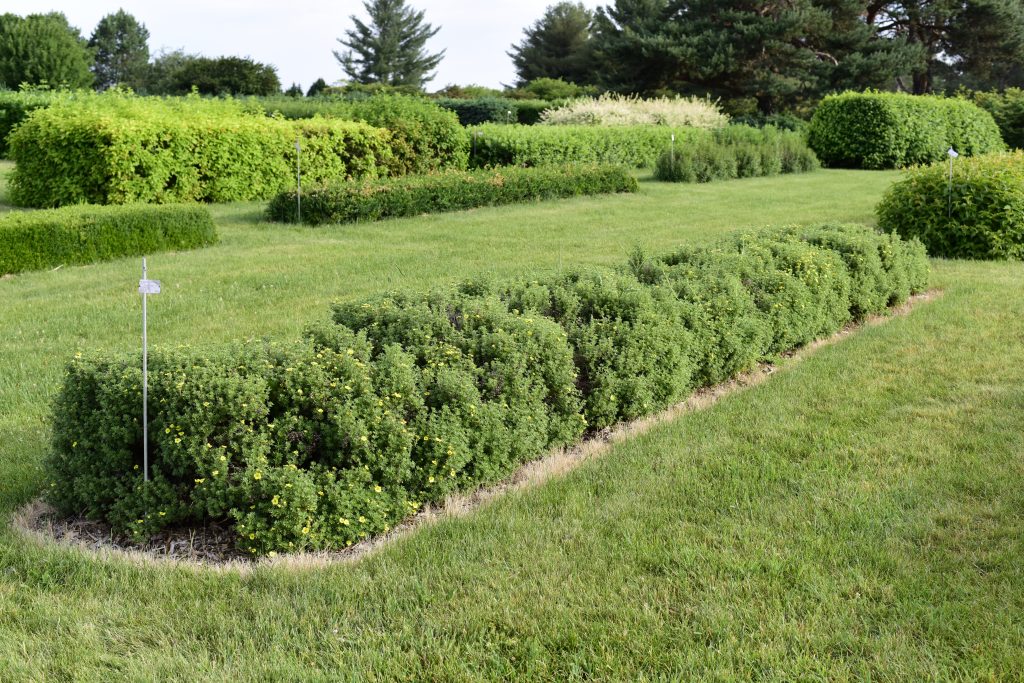 |
Form/Shape: | Best suited for a more rounded or organically shaped hedge |
| Privacy: | Not private; approximately 2-3ft tall at maturity | |
| Foliage: | Small, fern-like, green leaves are dense and provide textural interest | |
| Flower: | Blooms in late spring through fall with deep yellow flowers on new growth | |
| Maintenance: | Dense and compact growth provide less maintenance for shaping into a hedge | |
| Pest/Disease Issues: | Mildew in humid climates, fungal leaf spot and spider mites |
| Rhus aromatica – Fragrant Sumac (19650040) | ||
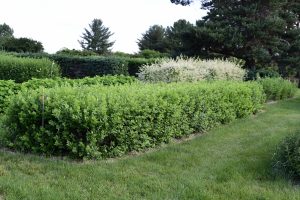 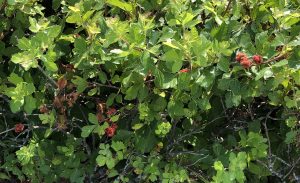 |
Form/Shape: | Best suited for a formal-shaped hedge due to dense foliage; softer and rounded edges with new growth |
| Privacy: | Semi-private; approximately 2-6ft tall at maturity | |
| Foliage: | Green trifoliate leaves with bluish hues provide textural interest with fall color resulting in leaf color ranging from red to purple to orange | |
| Flower: | Ornamentally insignificant; red berries may be showy | |
| Maintenance: | Dense foliage allows only a few weeds to grow through; growth appears to be slower, so less pruning | |
| Pest/Disease Issues: | Leaf spot, rust, scale, aphids, and mites; few issues |
| Salix integra ‘Hakuro-Nishiki’ – Dappled Willow (20080370) | ||
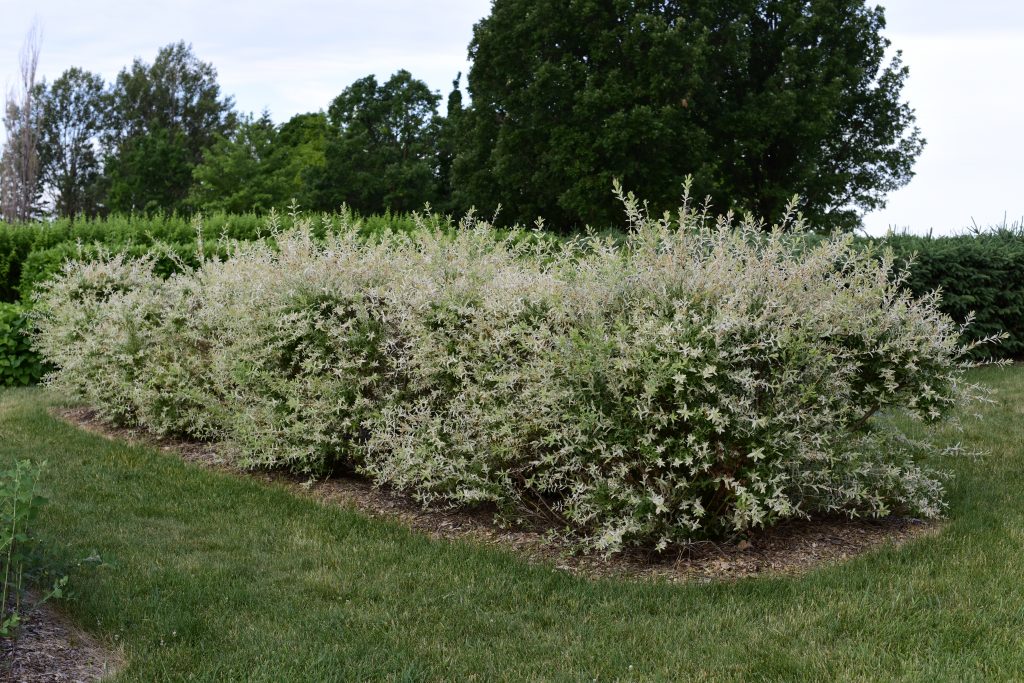 |
Form/Shape: | Best suited for a more rounded or organically shaped hedge due to airy and light foliage |
| Privacy: | Semi-private to private; approximately 4-6ft tall at maturity | |
| Foliage: | Shades of white, pink, and green variegated foliage on newer growth that fades to green in the late growing season; dense, but feathery (fine) with lance-shaped leaves | |
| Flower: | Ornamentally insignificant | |
| Maintenance: | Vigorous growth; few weeds growing through; to promote variegated coloration in foliage, annual pruning is necessary | |
| Pest/Disease Issues: | Blights, crown gall, powdery mildew, leaf spots, scab, rust, and canker |
| Salix purpurea ‘Nana’ – Dwarf Artic Willow (19530067) | ||
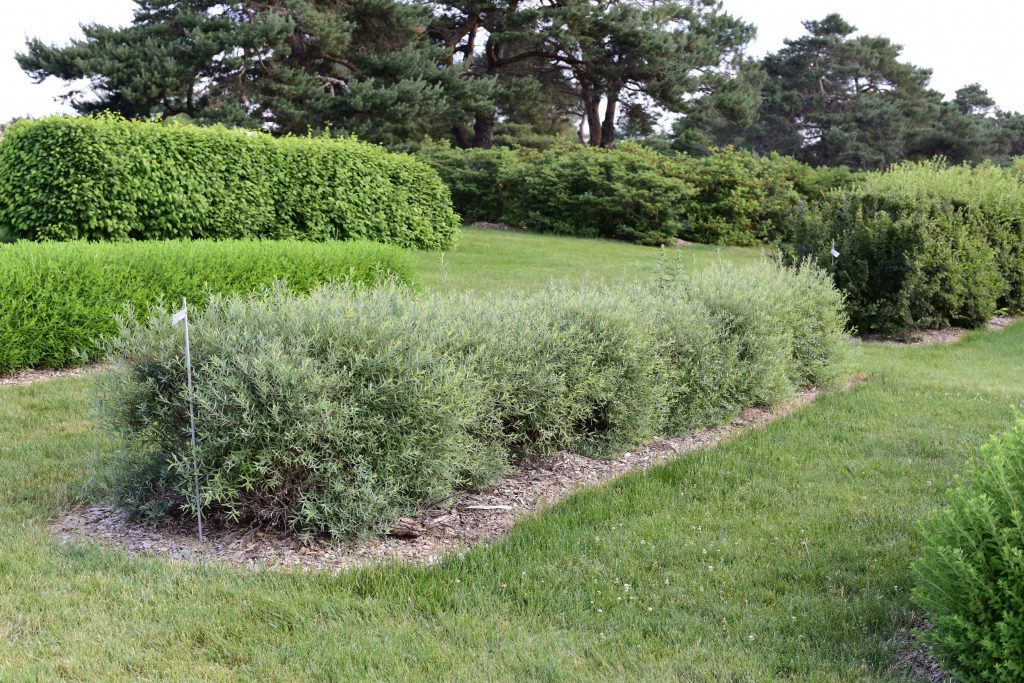 |
Form/Shape: | Best suited for a more rounded or organically shaped hedge due to airy and light foliage |
| Privacy: | Not private to semi-private; approximately 2-3ft tall at maturity | |
| Foliage: | Dense, but feathery (fine); bluish-silver hue with reddish stems | |
| Flower: | Ornamentally insignificant | |
| Maintenance: | Vigorous growth, but not unruly; some weeds growing through | |
| Pest/Disease Issues: | Blights, powdery mildew, leaf spots, gray scab, and canker |
| Thuja occidentalis ‘Wareana’ – Wareana American Arborvitae (19670714) | ||
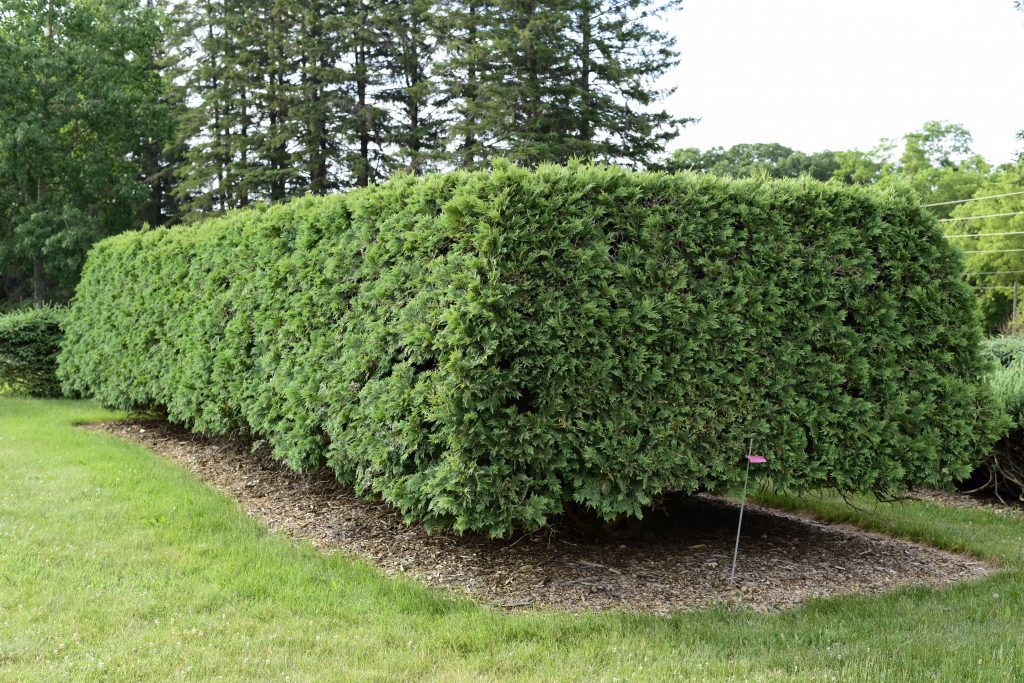 |
Form/Shape: | Best suited for a formal-shaped hedge due to dense, tidy growth with sharp, clean edges |
| Privacy: | Private; approximately 8-10 ft tall at maturity | |
| Foliage: | Dark green, evergreen foliage provides year-round interest; this selection is hardy to zone 3 and is less susceptible to winter burn | |
| Flower: | Ornamentally insignificant | |
| Maintenance: | Can grow up to a max of 1 foot per year; due to width and height of hedge, volume of maintenance is increased | |
| Pest/Disease Issues: | Leaf blight, canker, leaf miner, bagworms, mealybug, scale, spider mites, and winter burn |
| Viburnum dentatum ‘Christom’ Blue Muffin® – Arrowwood Viburnum (20110552) | ||
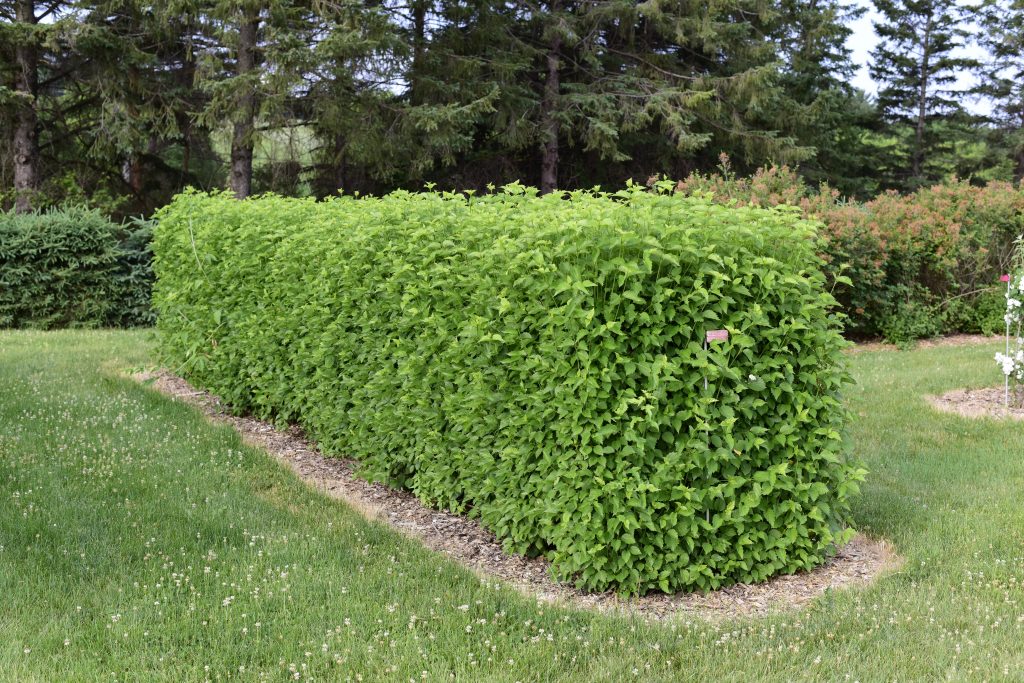 |
Form/Shape: | Best suited for a formal-shaped hedge due to dense foliage, tidiness, and height |
| Privacy: | Semi-private to private; approximately 3-5ft tall at maturity | |
| Foliage: | Dark green leaves that are toothed provide some textural interest; decent fall color with foliage changing to shades of yellow, orange, and red | |
| Flower: | Blooms in spring with white flowers in showy corymb inflorescences on old growth | |
| Maintenance: | Due to compactness and height of selection, once mature, pruning becomes less frequent; species has some drought tolerance, but may suffer during very prolonged heat and drought stress | |
| Pest/Disease Issues: | Minor; white flies, few pests |
| Weigela florida ‘Java Red’ – Java Red Weigela (20110553) | ||
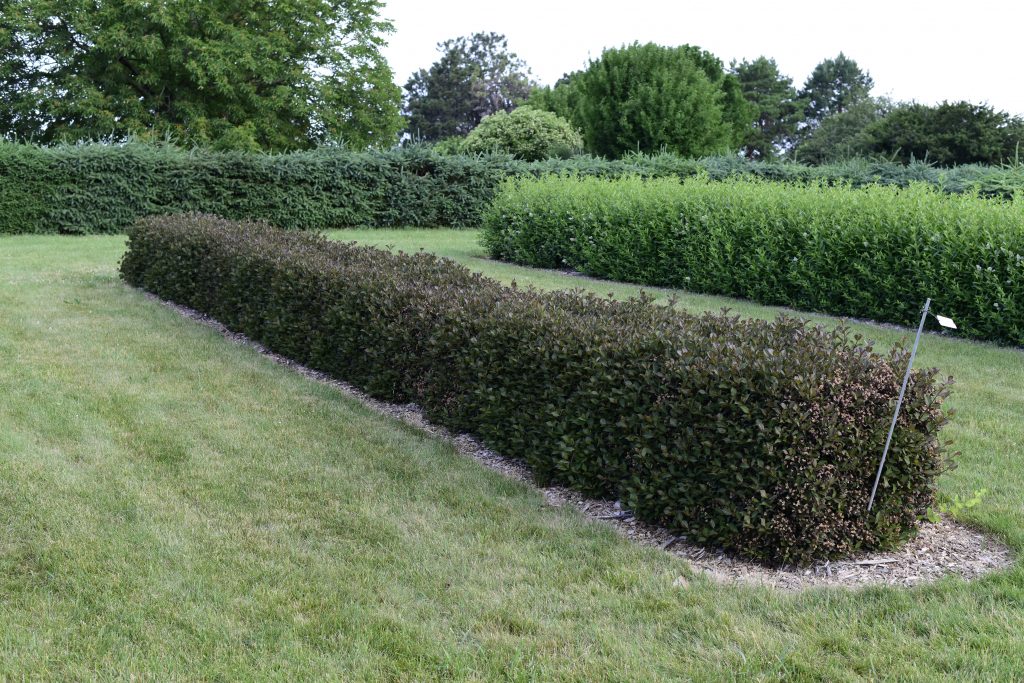 |
Form/Shape: | Best suited for a formal-shaped hedge due to dense foliage, tidiness, and sharp edges |
| Privacy: | Not private to semi-private; approximately 2 1/2-6ft tall at maturity |
|
| Foliage: | Showy deep purple leaves provide visual interest for the entire growing season; toothed leaves with contrasting venation provide textural interest | |
| Flower: | Blooms in late spring with deep pink flowers on old growth | |
| Maintenance: | Growth is slow; no holes in the hedge; no weeds growing through; may need frequent watering during heat or drought stress | |
| Pest/Disease Issues: | Minor; few pests |

